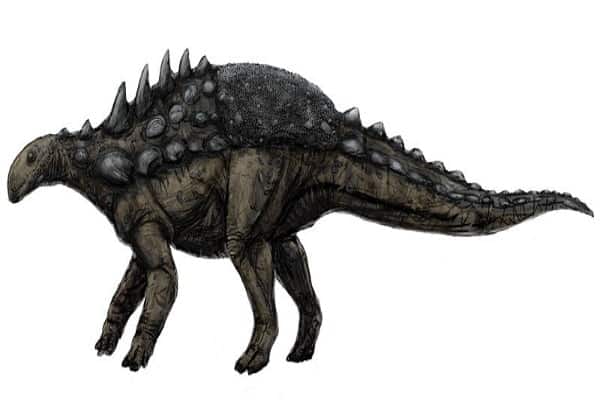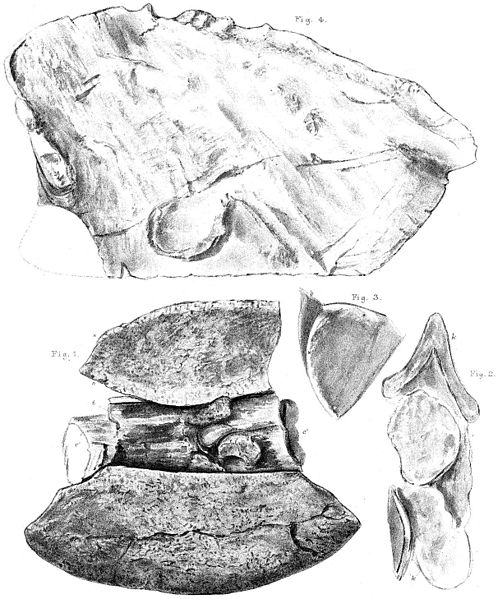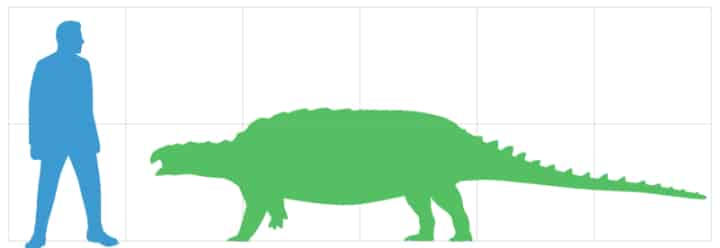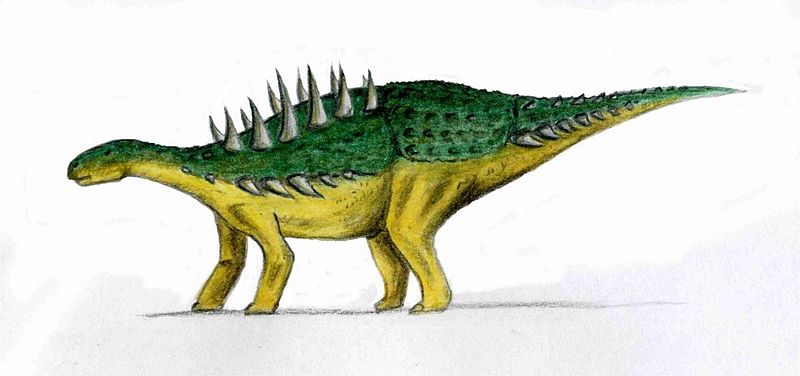There are few creatures that capture the imagination quite like the Polacanthus. This dinosaur, whose name means “many thorns” or “many spikes,” was an intimidating presence in the Early Cretaceous period. Its heavily armored body and distinctive features make it a fascinating subject of study for paleontologists and dinosaur enthusiasts alike.
The Polacanthus showcases incredible diversity and adaptability of life on Earth millions of years ago. Its unique characteristics and survival strategies provide valuable insights into the natural history of our planet. As we delve into the world of this dinosaur, we will uncover the secrets of this ancient creature and its place in the grand tapestry of life.
Polacanthus Key Facts
| Keyword | Fact |
|---|---|
| Polacanthus pronunciation | Pol-a-KAN-thus |
| Meaning of name | Many thorns or many spikes |
| Group | Ankylosauria |
| Type Species | Polacanthus foxii |
| Diet | Herbivore |
| When it Lived | Early Cretaceous |
| Epoch | Late/Upper Berriasian to Late/Upper Albian |
| Length | 16.4 ft |
| Height | 3.0 to 5.0 ft |
| Weight | 0.002 tons |
| Mobility | Moved on all four legs |
| First Discovery | 1865 by William Fox |
| Location of first find | Isle of Wight, England |
| First Described by | 1866 by William Fox |
| Holotype | NHMUK PV R175 |
Polacanthus Origins, Taxonomy and Timeline

The name Polacanthus is derived from the Greek words ‘polys’ meaning many and ‘akantha’ meaning thorn or spike. This aptly describes this dinosaur’s heavily armored body. This dinosaur belongs to the Ankylosauria group–a family of herbivorous dinosaurs known for their armored bodies and distinctive tail clubs.The taxonomic classification places it within the order Ornithischia, family Nodosauridae, and subfamily Polacanthidae. Its type species is Polacanthus foxii.
This herbivorous dinosaur roamed the Earth during the Early Cretaceous period. This was a time of significant change in the Earth’s climate and geography, with new types of vegetation emerging and the continents slowly moving towards their present-day positions.
Listen to Pronunciation
To get a better sense of how to pronounce Europasaurus, you can listen to the pronunciation here.
Discovery & Fossil Evidence

The first fossil was discovered in England in 1865 by William Fox. This initial find, a partial skeleton, was significant enough to allow paleontologist Richard Owen to describe and name the new dinosaur. Since then, additional fossils have been found in both England and Spain in order to provide further insights into this dinosaur’s physical characteristics and lifestyle.
Fossil evidence suggests that this was a quadrupedal dinosaur with a heavily armored body. The most notable specimens include a nearly complete skeleton found in the Isle of Wight, which has greatly contributed to our understanding of this dinosaur’s size, shape, and defensive capabilities.
Polacanthus Size and Description
As a quadrupedal dinosaur, it moved on all four legs. Its body was heavily armored with a dense covering of bony plates and spikes for protection against predators. The head was small compared to the body with a beak-like mouth for feeding on vegetation. Its neck was short and strong, leading to a robust body with a long, flexible tail. The limbs were stout and muscular, well-suited for supporting the dinosaur’s weight and moving its armored body.
The skin was likely tough and scaly, similar to modern reptiles. The dinosaur’s speed is not well-documented but given its heavy armor and stout limbs, it was likely not a fast runner. Instead, it relied on its armor for protection and stood its ground against predators.
Size and Weight of Type Species

This was a medium-sized dinosaur with an estimated length of about 16 feet. Given its heavy armor and robust body, it was likely a substantial creature but it’s difficult to provide a precise weight estimate without more fossil evidence.
The size and weight would have had significant implications for its lifestyle and behavior. A larger, heavier body would require more food and energy, influencing the dinosaur’s feeding habits and habitat preferences. It would also impact the dinosaur’s interactions with other species–including potential predators and competitors.
The Dinosaur in Detail
The Polacanthus was not just another dinosaur. Its unique features and adaptations set it apart from other dinosaurs of its time. The most striking feature was its heavy body armor. This armor was composed of bony plates and spikes that provided excellent protection against predators. It is a testament to the dinosaur’s adaptability and survival instincts.
One of the most notable specimens is the nearly complete skeleton found in the Isle of Wight. This specimen has greatly contributed to our understanding of the dinosaur’s physical characteristics and defensive capabilities. The skeleton reveals a robust, heavily armored dinosaur that was well-adapted to the challenges of its environment.
This dinosaur is a fascinating example of evolution in action. Its unique features and adaptations reflect the dynamic and ever-changing nature of life on Earth. As we continue to study this remarkable dinosaur, we gain valuable insights into the history of our planet and the incredible diversity of life it has supported.
The Polacanthus in its Natural Habitat

This herbivorous dinosaur lived during the Early Cretaceous period in a time of significant change in the Earth’s climate and geography. The European environment it inhabited was likely diverse with a variety of vegetation types available for this herbivorous dinosaur to feed on. The dinosaur’s heavy body armor suggests it faced significant threats from predators and required a robust defense mechanism.
It was a quadrupedal dinosaur that moved on all four legs. This mode of locomotion would have allowed it to navigate its environment effectively, whether it was traversing rough terrain or foraging for food.
As an herbivore, it fed primarily on vegetation. Its beak-like mouth would have been well-suited for stripping leaves from plants. The dinosaur’s diet would have influenced its habitat preferences with a need for areas rich in vegetation.
The social behavior of this dinosaur is not well-documented. However, like many dinosaurs, it may have lived in herds for protection. The dinosaur’s heavily armored body suggests it faced significant threats from predators and living in groups could have provided additional safety.
Interesting Points about Polacanthus
- The name means “many thorns” or “many spikes,” reflecting the dinosaur’s heavily armored body.
- It was a herbivore, feeding on vegetation in its environment.
- This dinosaur moved on all four legs, a trait common among heavily armored dinosaurs.
- William Fox discovered the first fossil in England in 1865.
- The nearly complete skeleton found in the Isle of Wight is one of the most notable specimens of this dinosaur.
Contemporary Dinosaurs
Amongst the fascinating European dinosaurs of the Early Cretaceous, the Polacanthus played the same resilient role as other armored dinosaurs. Some of these contemporaries help reveal other facets of the environment, each dinosaur its own example of the diversity of like at the time.
In this world the Polacanthus would have roamed alongside the Iguanodon, a dinosaur that was considerably larger. This size difference could have led to an interesting dynamic. The size and herbivorous diet of the Iguanodon might have made it a competitor for plant resources. And yet its sheer size could have deterred potential predators, indirectly providing a form of protection for the smaller Polacanthus.
The Hypsilophodon and Hylaeosaurus, both smaller than the Polacanthus, add more depth to this prehistoric picture. The Hypsilophodon was a swift and agile herbivore that might have shared similar food sources with the Polacanthus, leading to potential competition. The Hylaeosaurus, another armored dinosaur, could have been a close ally due to their shared defense mechanism forging a unique bond in the face of shared threats.
Then, there was the Baryonyx–a carnivorous dinosaur that could have posed a threat to the Polacanthus. The Baryonyx, with its long, crocodile-like jaws, was a formidable predator. Yet, the Polacanthus was not defenseless. Armor-like plates covered its body. This was providing it with a great level of protection against predators. This could have led to a tense yet balanced relationship between the two species.
In this intricate dance of survival, the Polacanthus and its contemporaries painted a vivid picture of life in the prehistoric world, each playing their part in the symphony of existence.
List of All Dinosaurs
We have created a list of all dinosaurs we have covered here, sorted across the seven main groups of dinosaurs. We also include information about their type of diet, (omnivore, herbivore or carnivore) and the time they lived.
Frequently Asked Questions
The name means “many thorns” or “many spikes,” reflecting the dinosaur’s heavily armored body.
It was an herbivore that fed primarily on vegetation using its beak-like mouth.
It was a quadrupedal dinosaur, moving on all four legs.
Sources
- https://royalsocietypublishing.org/doi/10.1098/rstl.1881.0015
- https://en.wikipedia.org/wiki/Polacanthus
- https://paleobiodb.org/classic/basicTaxonInfo?taxon_no=52784
- https://www.researchgate.net/publication/284097769_The_armoured_dinosaur_Polacanthus_foxi_from_the_Lower_Cretaceous_of_the_Isle_of_Wight
Article last fact checked: Joey Arboleda,06-08-2023
Featured Image Credit: FunkMonk (Michael B. H.), hip armour by Franz Nopcsa von Felső-Szilvás, CC BY-SA 3.0, via Wikimedia Commons
